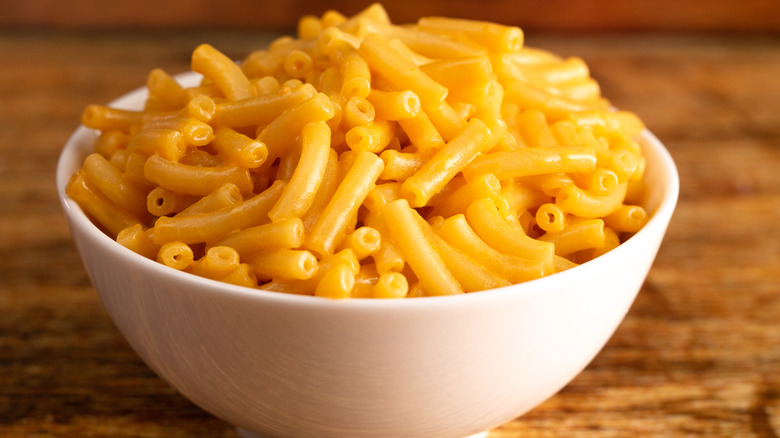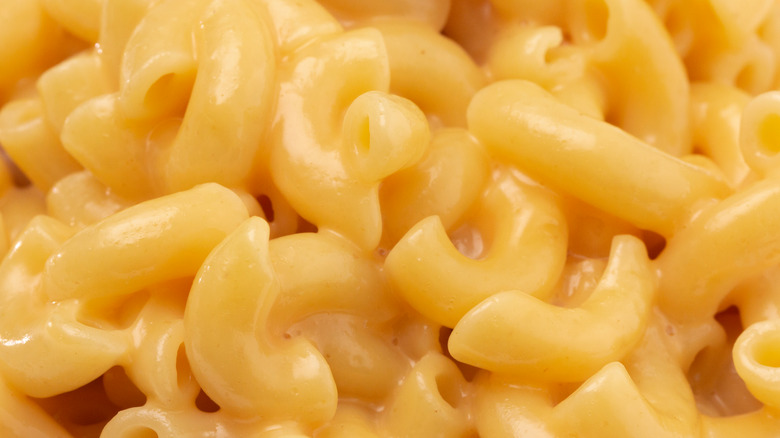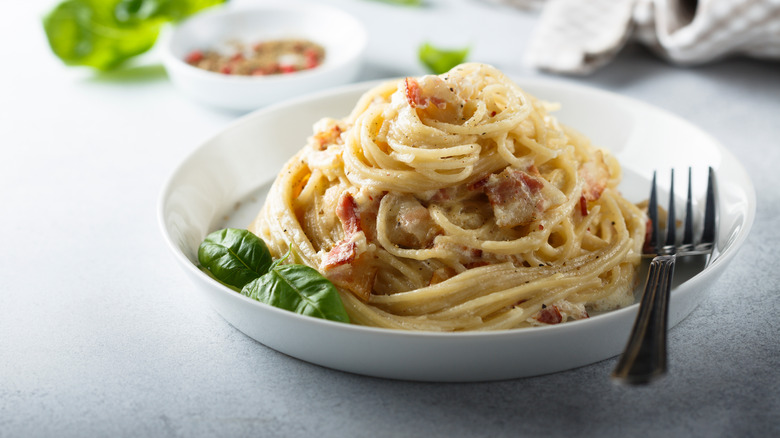Crack A Raw Egg Into Boxed Mac And Cheese For An Effortless Upgrade
We're all familiar with the classic blue box of mac and cheese. It comes with a packet of neon orange cheese powder, it's incredibly cheap, and if you're lucky, the noodles come in fun and crazy shapes that make it a little more special. Whether it's a side dish at dinner or a college kid's late-night meal, it's clear that Americans love digging into a pot of cheesy, gooey mac and cheese, no matter their age. Statista tells us that, in 2020, 8.95 million Americans consumed five or more boxes of mac and cheese in 2020 alone, making the blue box a relatively common sight in pantries across the country.
Is it popular? Sure. Is it high quality? Arguable. It's standard pre-prepared mac and cheese you got at the grocery store, so keep your expectations reasonable. This doesn't mean you can't experiment with it to make it taste better. You could, for example, put the finished mac and cheese in the oven for a few minutes to give it a nice, golden-brown crust on top, or add a variety of meats and vegetables from chicken and Buffalo sauce to bread crumbs and parsley.
While you may understand adding something like bacon or breadcrumbs to your mac and cheese, what's the point of adding an egg yolk?
The egg yolk gives the mac and cheese a custardy texture
While the idea does sound strange at first, considering you often don't associate eggs with boxed macaroni. But there's actually some benefit to adding an egg — or at least, an egg yolk — into your pot of standard pre-prepared macaroni and cheese.
The process is simple: prepare the macaroni and cheese as you usually would, adding or omitting whatever ingredients you prefer. After you've added the cheese powder, crack an egg and add only the yolk into the pot. Stir until the egg yolk is well-combined into the noodles — don't worry, the bright color of the yolk will be camouflaged by the neon orange of the noodles and cheese, so you don't have to worry about anyone noticing any wayward yolk in the pot.
The end result of adding an egg yolk should be that the mac and cheese has a much smoother, almost custard-like texture to it, thanks to the relatively high bonding power of the yolk. The texture will be glossy but will not have any taste of egg in it. The flavor won't be affected as much as the texture will be; it's an improvement over the sometimes clumpy, dry texture of pre-packaged macaroni and cheese.
As it turns out, eggs in pasta isn't a new idea.
Eggs can go in anything from macaroni to carbonara
The idea of adding eggs to pasta may sound like something off social media. In truth, egg yolks in pasta has been a relatively common practice, from carbonara to Japanese pasta dishes.
One such dish example is Pasta Cacio e Uova, a take on carbonara that substitutes the usual addition of meat for eggs and cheese. Using egg yolk in the dish helps ensure that the pasta has the trademark creaminess you expect in traditional carbonara. Combined with the cheese, the eggs create a smooth sauce that doesn't clump the pasta together but gives it a light and velvety texture. Japanese carbonara also includes an egg combining beaten eggs with miso for a rich and flavorful sauce.
Of course, while it's possible that you can wind up cooking the egg while you mix it into the pasta, it's usually advised that you prepare it over low heat and not stir it so quickly to prevent the egg from breaking up and scrambling. If you worry about the taste of egg in your dish, add as much seasoning as you want to hide the taste, although most recipes assure that there's little to no taste of egg whatsoever.
If you don't want to stir an egg into your pasta, maybe you could try topping it with a fried egg.


